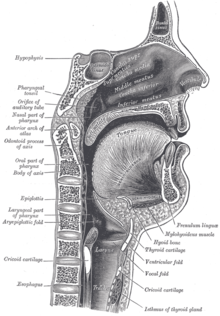Swallowing act
The act of swallowing is a complex process that is used to move food and saliva from the oral cavity into the stomach without obstructing the airways .
The act of swallowing is initially prepared arbitrarily. By stimulating the base of the tongue , the involuntary swallowing reflex is triggered, which means that the subsequent processes evade voluntary influence. Impairments to the act of swallowing are known as swallowing disorders .
Anatomy and physiology
On average, there are 1000 to 3000 swallowing processes per day in humans (much less frequently in the sleeping phase than in the waking phase). The function of the swallowing process is not only to transport the bolus of food into the stomach, but also to clean the esophagus, in particular to remove the stomach acid that has entered the esophagus . The increased nocturnal symptoms associated with reflux disease can therefore be partly attributed to the reduced frequency of swallowing activity at night.
Anatomical structures
The anatomical structures of the oral cavity or its boundaries, the throat and larynx , the esophagus and the stomach are involved in the swallowing process . The interaction of the 26 muscle pairs involved is coordinated by the swallowing center in the brain stem and higher suprabulbar and cortical centers .
The five pairs of cranial nerves involved are
The three cervical nerves involved come from segments C1 to C3.
Swallowing reflex
The swallowing reflex is a foreign reflex that has already developed prenatally , which enables the intake of food and fluids without endangering the airways . It determines the process of swallowing in healthy people on several levels.
The corresponding stimulus for triggering the reflex is the touch of the mucous membrane in the area of the base of the tongue, the narrow pharynx (palatal arches) or the back wall of the pharynx . Via the mechanoreceptors and afferent (supplying, i.e. leading to the brain) fibers of the Pharyngeal plexus ( glossopharyngeal nerve and vagus nerve ), the information is processed in the medulla oblongata (the so-called elongated medulla) of the brain stem .
Swallow size and duration
The size of the swallow varies greatly and depends on the type of food. About 20 g of watery food pulp or a maximum of 40 ml of liquid (hasty drinking) can be consumed per sip. (To provide a frame of reference: One soup spoon contains 10 ml.)
When eating, the length of time you swallow depends on how well the bite is chewed and mixed with saliva. The passage time through the esophagus is approximately 8-20 seconds.
Individual phases
The act of swallowing in the narrower sense consists of three transport phases. However, what happens first is just as important - especially when eating solid foods. The following classification is made: A preparatory phase is followed by the mouth, throat and finally the esophagus phase:
Oral preparation phase
The oral preparation phase summarizes those processes that precede the actual swallowing process and make it possible in the first place. A bite of food must first be small enough to be able to chew it sufficiently . The chopped up food is mixed with saliva and made slippery. The prerequisite for this is the undisturbed function of the lips , teeth and the tooth-supporting apparatus , the temporomandibular joint and masticatory muscles, as well as the tongue and the salivary glands .
Ultimately, a 5–20 ml food bolus is created.
Oral transport phase
This phase is only partially subject to arbitrary control: while you can chew with your mouth open, the lips are now closed in order to avoid loss of saliva and the swallowing of air ( aerophagia ); the cheek muscle is tensed. At the start of the swallowing process, the tongue is pressed against the hard palate - this thus serves as an abutment - and the bolus with a backward wave-like movement (supported by the styloglossus and hyoglossus muscles , which pull the tongue backwards like a punch) over the Narrow throat pushed into the throat.
The swallowing reflex is only triggered when the base of the tongue or the back of the throat are touched by the food bolus. From this point, the further process may partially or after a relevant only swallow training are affected.
Pharyngeal transport phase
In this phase, both the upper and lower airways are sealed in order to prevent the pulp from entering the nose or swallowing:
- The soft palate is tensed and lifted to prevent the pulp from passing into the upper airways. This is ensured by the “tensioners and lifters of the soft palate” ( Musculus tensor veli palatini and Musculus levator veli palatini ). Both muscles also expand the ear trumpet ( tuba auditiva ), which explains why there is a pressure equalization between the middle ear and a different external pressure when swallowing . This can be used in a targeted manner in the event of rapid changes in the ambient pressure (aircraft take-off, landing).
- The upper pharyngeal constrictor muscle ( musculus constrictor pharyngis superior , more precisely its pars pterygopharyngea ) contracts and forms the so -called passavant annular bulge , to which the soft palate rests, so that the upper airways are now completely closed and no more food can get into the nose .
- Clinical reference: In the case of soft palate paralysis , for example after diphtheria , this locking mechanism is insufficient and food or liquid enters the nose.
- the vocal folds close
- the epiglottis ( epiglottis ) is through the base of the tongue (with the assistance of the musculus aryepiglotticus lowered)
- the muscles of the floor of the mouth contracts; The larynx and hyoid bone rise by about 2 cm, which can be felt well and - at least in men - also clearly seen. This so-called "larynx elevation" is supported by the mylohyoid , digastric and stylohyoid muscles (which lift the hyoid bone) and the thyrohyoid muscle (which the larynx).
As you step up your larynx, two things happen at the same time:
- The epiglottis and larynx entrance are approaching each other - and thus the lower airways are now triple protected
- the upper esophageal sphincter (the upper esophageal sphincter or mouth ) opens. This leaves the way for the food bolus for further transport.
By contraction of the middle and lower pharyngeal constricting muscles ( musculi constrictores pharyngis medius et inferior ) above the bite, this is transported towards the esophagus and injected into it.
Esophageal transport phase
After the food bolus enters the esophagus , the sphincter closes again. This means that another closure of the airways no longer makes sense and these are opened again. In an upright posture, the bolus slides through the esophagus to the stomach, but the peristalsis of the esophagus can also move the bolus against gravity ( when standing on the head) or when lying down. The cardia opens; After the bolus has entered the stomach, it closes again and the act of swallowing is over.
Swallowing act and age
During the pregnancy is amniotic fluid volume to a large extent by the fetus regulates itself: Starting from the 15th week of pregnancy can drink amniotic fluid - the end of pregnancy about 400 ml daily. Thus, the amount of amniotic fluid that is present, in addition to undisturbed micturition (urine excretion), is particularly dependent on an undisturbed act of swallowing.
- Clinical reference: It comes with malformations in the central nervous system (such as a anencephaly ) or the digestive tract (such as esophageal atresia ) mostly to form a polyhydramnios .
In newborns, the larynx is much higher in the throat than later, so that the infant can still breathe and drink at the same time without choking . The epiglottis is higher than the base of the tongue and the food is transported directly into the esophagus via the piriform recess on both sides of the larynx. The infant can breathe through the nose and drink through the mouth at the same time. However, this reduces the size of the pharynx, preventing the formation of complex sounds such as vowels , which are essential for learning a language . Only when the larynx sinks after about three months does the throat become larger. From then on, the infant can not only make complex sounds, but (theoretically) also snore.
Diagnosis
The diagnosis of swallowing disorders has been significantly expanded with video cinematography of the act of swallowing .
If dysphagia is suspected, a comprehensive clinical swallowing examination should be carried out by speech therapists / speech therapists (medical history, examination of the structures involved in swallowing, including cranial nerve status, swallowing attempts). The most important apparatus-based methods for determining the cause, type and severity of dysphagia are video fluoroscopy (Videofluoroscopic Swallowing Study; VFSS) and video endoscopy of swallowing (Flexible Endoscopic Evaluation of Swallowing; FEES).
Non-mammals

In many birds , food slides through the esophagus solely with the help of gravity. When a seagull swallows a fish or a stork swallows a frog, they primarily raise their head so that the beak points up and the prey can slide down. They use their tongue and cheeks to help guide the food in the right direction.
In fish , the tongue is largely bony and much less mobile. The food is washed down the throat with water, which comes out of the gills .
Snakes first move their lower jaw to move food into their bodies. As soon as the prey is deep enough in them, it is carried on by peristaltic movements of their body muscles.
See also
Individual evidence
- ↑ Benninghoff Drenckhahn, Anatomy: Macroscopic Anatomy, Histology, Embryology, Cell Biology, Vol. 1, 16th edition, Urban and Fischer, ISBN 3-437-42340-1 .
- ↑ Video cinematography of the act of swallowing: standard indications .
- ↑ Guidelines for Diagnostics and Therapy in Neurology, Neurogenic Dysphagia, 2008.

